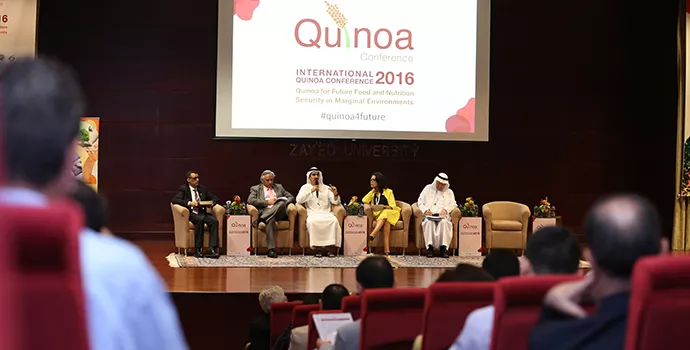Dubai hosts biggest international conference on quinoa
6 December 2016
Leaders, scientists and experts from around the world gathered today at one of the biggest international conferences dedicated to quinoa since 2013 was declared the International Year of Quinoa by the United Nations.
More than 150 leaders, policymakers, scientists, experts and professionals from over 46 countries came together to discuss and share the latest developments in quinoa research, production and trade around the world, and develop a set of recommendations for quinoa cultivation in marginal environments which are affected by water scarcity and salinity.
The global population is forecast to increase to 9.7 billion in 2050 and there are concerns about the capacity of agriculture to produce enough food for the growing population. By some estimates, food production will need to go up by about 60 percent either through an increase in crop yields per unit area or an expansion in the arable land by 2050 to meet the demand. Furthermore, several regions already suffering from malnutrition, water scarcity and soil degradation are forecast to have a large population growth, which raises concerns about whether traditional agricultural methods and crop species will have the capacity to sustain global food production targets.
People living in marginal environments are particularly vulnerable to the impact of climate change on agriculture. Therefore, there is an urgent need to identify solutions to sustaining and possibly increasing agricultural productivity in areas where growing traditional crops has become difficult and sometimes uneconomical. Quinoa is widely considered a promising crop that can contribute to addressing these challenges.
Addressing participants at the opening ceremony, His Excellency Dr. Thani Ahmed Al Zeyoudi, Minister of Climate Change and Environment of the UAE, said: “Climate change poses one of the greatest threats to humanity. Countries that already suffer from droughts, water shortages, and salinity are at an even greater risk. We urgently need to find solutions and adapt and where possible mitigate effects of climate change on different fronts, including agriculture. Ensuring future food security in marginal environments requires a shift in agricultural practices and innovative approaches to crop production systems. Quinoa can play a major role as a staple crop in marginal environments due to its adaptability to harsh environments including poor saline soils with annual rainfall as little as 200 mm.”
In his statement, Professor Reyadh AlMehaideb, Vice President of Zayed University, said: “We are pleased to host this international conference at Zayed University. It is a timely event as the world faces the implications of grand environmental challenges, and many countries experience food and nutrition insecurity as well as impacts from climate change. We believe that the conference will be an excellent platform for scientists and experts to look at these challenges and come up with a shared vision on how crops like quinoa that grows in marginal land can help address them.”
An Oxfam study in 2009 showed that 45.9% of the poor in Sub-Saharan Africa and 25.3% in Asia live in marginal environments. According to FAO’s ‘The State of Food Insecurity in the World 2015’, 793 million people are undernourished globally.
Despite the growing global recognition of quinoa’s potential, and positive research outcomes in pilot studies in recent years, there are still many constraints and issues to be addressed before quinoa becomes a crop of choice in marginal areas where major crops have long been dominant but are progressively failing to withstand increasing salinity and lack of water.
Speaking at the conference, Dr. Ismahane Elouafi, Director General of the International Center for Biosaline Agriculture (ICBA), said: “There has been considerable research on quinoa in recent years. Scientists at ICBA have also evaluated and tested the performance of several quinoa cultivars for their productivity when grown in marginal conditions. However, there are still many areas to be researched and improved as we introduce quinoa into agriculture in marginal environments, in order to make sure its introduction and production systems are beneficial to the communities and their ecosystems now and in the future."
These challenges include, among others, limited availability of genetic material for cultivation outside the Andes, limited knowledge of best management practices – especially nutrient and water requirements, pest and disease control, harvesting and processing under marginal growing conditions, and lack of suitable marketing channels where smallholder farmers could sell their produce.
Mr. Abdessalam Saleh Ould Ahmed, FAO Assistant Director General and Regional Representative for the Near East and North Africa, said: “The United Nations declared 2013 the International Year of Quinoa and this gave a renewed impetus to efforts to study nutritional, economic, environmental and cultural value of this food. We hope that this conference will be a turning point in raising awareness on the potential of quinoa for food and nutrition security in marginal environments.”
Held under the title of ‘Quinoa for Future Food and Nutrition Security in Marginal Environments’ and running through December 8, the conference seeks to find ways to implement research and development programs and initiatives to introduce and scale up quinoa in marginal environments.
The conference is also aimed at building partnerships between public and private institutions, research and development organizations, and serving as a platform for the transfer of the latest innovation and knowledge on quinoa.
Held under the patronage of Her Excellency Sheikha Lubna bint Khalid Al Qasimi, Minister of State for Tolerance of the UAE and President of Zayed University, the conference is organized by the International Center for Biosaline Agriculture (ICBA) in collaboration with the Ministry of Climate Change and Environment of the United Arab Emirates, Zayed University, the Islamic Development Bank (IsDB), the Arab Bank for Economic Development in Africa (BADEA), and with the technical contribution of the Food and Agriculture Organization of the United Nations (FAO).











